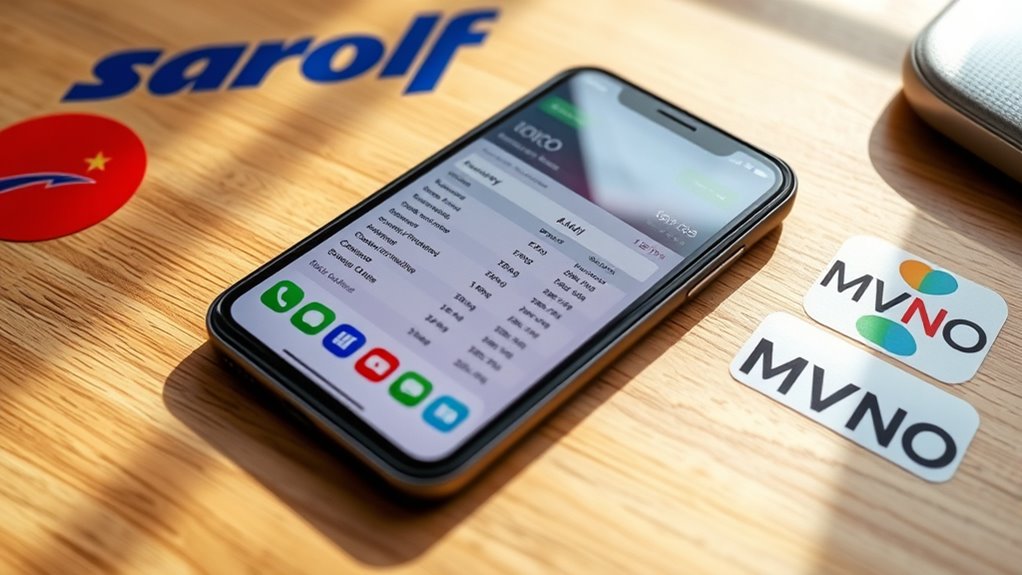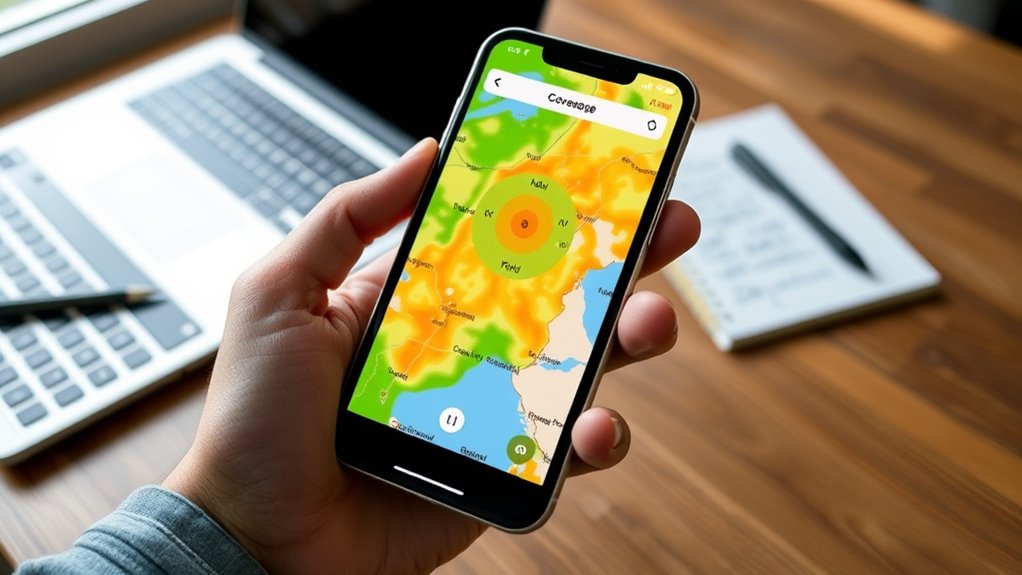Switching MVNOs can save you lots on your phone bill without sacrificing coverage or service quality. Start by comparing plans, prices, and coverage to find the best fit for your needs. Make sure your device is compatible and *unlocked* before transferring your number smoothly. Keep track of promotions and monitor your usage to avoid extra charges. Want to discover more tips for seamless switching and maximizing savings? Continue exploring for expert advice.
Key Takeaways
- Research and compare MVNO plans for better rates, coverage, and features before switching.
- Prepare your current account details and device compatibility to ensure a smooth transfer.
- Use promotions, referral bonuses, and bundle deals to maximize savings when choosing a new MVNO.
- Monitor data usage regularly to avoid overage charges and adjust plans as your needs change.
- Keep your current service active until the number transfer completes to prevent service interruptions.
Understanding What MVNOs Are and How They Work

Many people aren’t aware that Mobile Virtual Network Operators (MVNOs) are companies that lease network access from major carriers and sell it under their own brand. They don’t own the infrastructure but rely on existing networks like Verizon, AT&T, or T-Mobile. This setup allows MVNOs to offer competitive prices, often with flexible plans and fewer fees. When you sign up with an MVNO, you’re fundamentally renting space on a network owned by a big carrier, but dealing directly with the MVNO for your service. They handle billing, customer support, and plans, making it easier to find affordable options. Because they don’t maintain their own infrastructure, MVNOs can pass savings onto you, helping you cut your phone bill without sacrificing coverage. Understanding the role of network technology helps explain how MVNOs can provide reliable service at lower costs. Additionally, many MVNOs utilize network sharing agreements, which further enhances their ability to deliver coverage comparable to major carriers at reduced prices. Recognizing the importance of network infrastructure clarifies how MVNOs maintain service quality despite not owning physical networks, and ongoing advancements in wireless technology continue to improve the customer experience. Furthermore, the evolving regulatory environment can influence how MVNOs operate and set their prices, impacting consumers directly.
Comparing Major Carriers and Popular MVNO Options

Are you trying to decide between major carriers and MVNO options for your phone plan? Comparing them helps you find the best fit. Major carriers like Verizon, AT&T, and T-Mobile offer extensive coverage, premium features, and reliable customer support. However, they tend to be pricier. MVNOs, such as Mint Mobile, Boost, and Cricket, typically cost less and provide flexible plans. Keep in mind:
- Major carriers often have better coverage in rural areas
- MVNOs usually offer lower monthly rates
- Major carriers may include more perks like device financing
- MVNO plans often have fewer added features
Knowing what you value most—coverage, cost, or extras—will guide your choice. Both options can meet different needs, so weigh the benefits against your priorities. Selecting a Vetted provider ensures you receive reliable service and support. Additionally, understanding the coverage options can help you choose the best provider for your location and usage needs. Considering the diversification benefits of different plans can also help optimize your overall mobile strategy. To make an informed decision, exploring wall organization solutions can sometimes reveal hidden costs or benefits in your plan options. Incorporating retirement planning strategies, such as choosing carriers with flexible plans, can also add value over the long term.
Evaluating Plans and Pricing to Maximize Savings

When comparing plans and pricing options, focusing on the details can help you maximize savings. Look beyond the base price and examine data limits, call and text allowances, and add-on options. Some plans offer unlimited calls and texts but charge extra for high data usage, so choose a plan that matches your habits. Check for hidden fees, activation costs, or discounts for autopay and paperless billing. Consider whether a plan offers flexible data options or rollover features, which can save you money if your usage varies. Also, evaluate the contract length—prepaid plans often provide more control and fewer commitments. By analyzing these factors carefully, you can select a plan that aligns with your usage patterns, ensuring you get the most value without overspending.
Checking Coverage and Network Reliability Before Switching

Wondering if your new carrier will keep you connected wherever you go? Before switching, it’s vital to check coverage and network reliability in your typical areas. You don’t want unexpected dead zones or dropped calls to ruin your experience. To do this, review coverage maps provided by the MVNO and compare them with your regular routes and frequent locations. Talk to current users or read reviews about their real-world experience. Also, consider testing the network with a prepaid SIM or trial period if available. Focus on these key points:
- Coverage in your home, work, and commuting routes
- Signal strength during peak and off-peak hours
- Network speed and data reliability
- Customer reviews on network consistency
Ensuring solid coverage helps you avoid surprises and guarantees dependable service. Additionally, reviewing network performance data can provide insight into the stability and efficiency of the MVNO’s services in your area. Conducting a coverage test in your typical environments can further confirm the service quality before making a switch. Researching regulatory standards can also help you understand the protections and quality benchmarks the carrier adheres to. Confirming that the carrier meets coverage standards ensures you receive consistent service in various environments. Checking network reliability across different locations can further help you avoid disruptions and maintain uninterrupted connectivity.
Tips for Seamlessly Transitioning to a New MVNO

Before switching to a new MVNO, make sure to prepare your current account to avoid interruptions. Research plans that suit your needs and verify they’re compatible with your device. Additionally, consider reviewing vegetable juices and other lifestyle tips to ensure a seamless transition and avoid potential service disruptions. Staying informed about content discoverability and platform features can help you optimize your experience during the switch. Conducting market research can also help you identify the best plans and providers suited to your usage patterns. Being aware of cookie management options can further enhance your online experience while exploring different providers.
Prepare Your Current Account
To guarantee a smooth switch to your new MVNO, start by reviewing your current account details carefully. Check your billing cycle, remaining data, and any pending charges. Make note of your account number, phone number, and plan specifics, as these might be needed during the transition. Make certain there are no unresolved payments or unpaid bills that could delay your transfer. It’s also a good idea to:
- Verify your account information matches your ID
- Cancel any auto-renewals or subscriptions linked to your current plan
- Backup important contacts and messages
- Confirm your device is unlocked and compatible with the new provider
- Be aware of Angel Number Soulmate signs indicating a new love or relationship during your transition process
- Understand the activation process involved in switching providers to ensure everything proceeds smoothly
Taking these steps prevents surprises and guarantees your switch is seamless, letting you enjoy your new service without interruption.
Research Compatible Plans
Start by researching which plans are compatible with your device and meet your usage needs. Check if your current phone is unlocked and supports the network technology used by the MVNO you’re considering. Review the plans offered, focusing on data limits, call minutes, and text allowances to guarantee they match your habits. Compare prices and see if any plans include perks like hotspot data or international calling. Read customer reviews to gauge network reliability and customer service. Confirm whether the plan requires a contract or if it’s pay-as-you-go, depending on your preference. Make sure the plan’s coverage area aligns with where you’ll use your phone most. Doing this homework helps you avoid surprises and ensures a smooth switch to your new provider.
Transfer Your Number Easily
Transferring your number to a new MVNO is straightforward if you follow a few key steps. First, don’t cancel your current plan before the transfer; your existing provider needs to release your number. Next, gather your account information, including your account number and PIN or password. Contact your new MVNO and provide them with this info. They’ll handle the transfer process, which usually takes a few hours to a day.
To ensure a smooth switch, keep these tips in mind:
- Keep your current service active until the transfer completes
- Do not change your number or account info during the process
- Confirm with your current provider that your number is eligible for transfer
- Be available for any verification requests during the process
Leveraging Promotions and Discounts for Extra Savings

Taking advantage of promotions and discounts can considerably lower your phone bill, especially when you stay alert for limited-time offers and special deals. Many MVNOs frequently run promotions like discounted rates for new customers, referral bonuses, or bundle deals on data plans. Signing up during these periods can save you a significant amount upfront. Additionally, look for loyalty discounts or seasonal promotions that provide ongoing savings. Some providers also offer device discounts or free accessories as part of their promotional campaigns. To maximize savings, compare deals across different MVNOs regularly and subscribe to their newsletters or follow on social media for instant alerts. Staying proactive in hunting for these deals ensures you get the best value without sacrificing service quality.
Monitoring Your Usage to Avoid Overcharges

To avoid unexpected charges, you should regularly track your data usage through your phone or carrier app. Setting usage alerts can notify you before you hit your limit, giving you time to adjust. Staying aware of your consumption helps keep your bill in check and prevents costly overages.
Track Data Usage
Monitoring your data usage regularly is essential to avoid unexpected overcharges on your phone bill. By keeping an eye on your consumption, you can identify patterns and adjust your habits accordingly. Most MVNOs offer apps or online portals where you can check your data in real-time. Remember to:
- Track your daily and weekly usage to spot spikes early
- Understand your plan’s data limits to prevent excess charges
- Recognize which apps consume the most data
- Set aside specific times to review your usage, avoiding surprises at billing time
Staying proactive helps you stay within your data cap, saving money and avoiding disruptions. Regular monitoring ensures you’re aware of your consumption and can make adjustments before exceeding your plan’s limits.
Set Usage Alerts
Setting usage alerts is one of the most effective ways to prevent unexpected overcharges on your phone bill. Most MVNOs allow you to set custom alerts for data, minutes, and texts through their apps or online portals. You can choose thresholds that matter to you, like 80% of your plan’s limit, so you’re notified before hitting overage charges. Once alerts are set, you get real-time updates, giving you the chance to reduce usage or switch to Wi-Fi. This proactive approach helps you stay in control and avoid costly surprises at billing time. Regularly review your alerts and adjust them as your usage habits change. Setting these alerts is a simple step that can save you money and keep your phone expenses predictable.
Frequently Asked Questions
How Do I Transfer My Existing Phone Number to a New MVNO?
To transfer your existing phone number to a new MVNO, you need to start by contacting your current provider and requesting a transfer or port-out. Make sure you have your account details and your current phone number ready. Then, provide this info to your new MVNO when you sign up. They’ll handle the transfer process, which usually takes a few hours to a couple of days to complete.
Are There Any Hidden Fees When Switching MVNO Providers?
You might be surprised, but many people overlook hidden fees when switching MVNO providers. While most companies are transparent about costs, some sneaky charges could pop up, like activation fees or device charges. It’s smart to read the fine print and ask questions upfront. By doing your homework, you’ll avoid surprises and make certain a smooth transition without unexpected expenses sneaking in.
Can I Keep My Current Phone When Switching to an MVNO?
You can usually keep your current phone when switching to an MVNO, but it depends on your device and carrier compatibility. First, check if your phone is freed and supports the new network’s technology (GSM or CDMA). If it is, you can often transfer your SIM card and keep your phone. Contact your new MVNO to confirm compatibility and guarantee a smooth switch without needing a new device.
What Should I Do if My Coverage Is Poor After Switching?
Did you know that about 20% of mobile users experience coverage issues after switching providers? If your coverage is poor, first, restart your device to refresh the signal. Then, check your phone’s settings and verify the correct network mode is selected. If problems persist, contact your new provider’s customer support—they might suggest network updates or help troubleshoot coverage issues. Sometimes, switching to a different tower or provider might be necessary for better service.
How Do MVNOS Handle Emergency Services and 911 Calls?
When you dial 911 on an MVNO, your call should connect just like with any major carrier. Most MVNOs use the networks of big providers, ensuring access to emergency services. However, coverage can vary, so it’s smart to check your MVNO’s emergency call policies and network partnerships. Always keep your location updated and consider carrying a backup communication method for emergencies.
Conclusion
Switching MVNOs is like finding a hidden treasure chest—unlocking savings and better coverage. By understanding your options, comparing plans, and watching your usage, you’ll navigate this journey smoothly. Don’t be afraid to explore promotions and ask questions along the way. Think of your phone plan as a garden; with a little care and attention, it’ll flourish without draining your wallet. Embrace these hacks, and watch your phone bill bloom.









